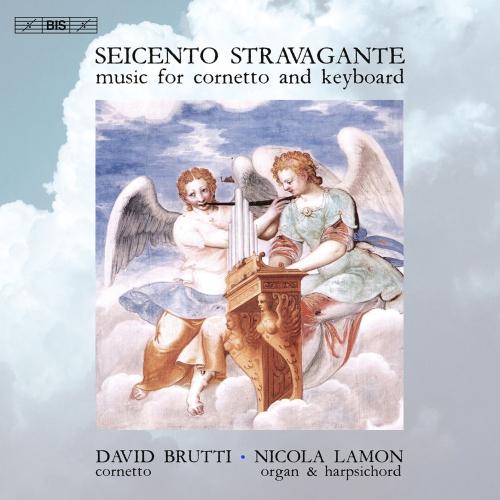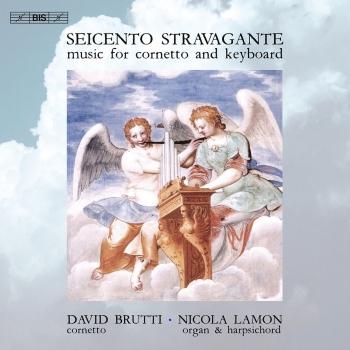
Seicento stravagante: Music for Cornetto & Keyboard David Brutti & Nicola Lamon
Album info
Album-Release:
2023
HRA-Release:
03.02.2023
Label: BIS
Genre: Classical
Subgenre: Chamber Music
Artist: David Brutti & Nicola Lamon
Composer: Giovanni Battista Fontana (1571-1631), Girolamo Frescobaldi (1583-1643), Annibale Padovano (1527-1575), Dario Castello (1590-1631), Giovanni Gabrieli (1554-1612), Giovanni Girolamo Kapsberger (1580-1651), Francesco Rognoni (1570-1626), Angelo Notari
Album including Album cover Booklet (PDF)
- Giovanni Battista Fontana (1589 - 1630): Violin Sonata in C Major, F 1475.03 (Arr. for Cornetto & Continuo):
- 1 Fontana: Violin Sonata in C Major, F 1475.03 (Arr. for Cornetto & Continuo) 04:33
- Girolamo Frescobaldi (1583 - 1643): Canzon Terza detta "La Lucchesina" (Arr. for Cornetto & Continuo):
- 2 Frescobaldi: Canzon Terza detta "La Lucchesina" (Arr. for Cornetto & Continuo) 04:07
- Annibale Padovano (1527 - 1575): Toccata VI tono:
- 3 Padovano: Toccata VI tono 04:28
- Dario Castello (1602 - 1631): Sonate concertate in stil moderno, Book 2:
- 4 Castello: Sonate concertate in stil moderno, Book 2: No. 1, — 04:33
- Andrea Gabrieli (1533 - 1585): Canzoni alla francese:
- 5 Gabrieli: Canzoni alla francese: No. 7, Qui la dira 05:39
- Girolamo Kapsberger (1580 - 1651): Sinfonia No. 13 (Arr. for Cornetto & Continuo):
- 6 Kapsberger: Sinfonia No. 13 (Arr. for Cornetto & Continuo) 02:07
- Andrea Falconieri (1585 - 1656): La monarca (Arr. for Cornetto & Continuo):
- 7 Falconieri: La monarca (Arr. for Cornetto & Continuo) 03:00
- Riccardo Rognoni (1550 - 1620): Ung gay Berger (Arr. for Cornetto & Continuo):
- 8 Rognoni: Ung gay Berger (Arr. for Cornetto & Continuo) 03:21
- Angelo Notari (1566 - 1663): Ahi, che s'acresce in me (Arr. for Cornetto & Continuo):
- 9 Notari: Ahi, che s'acresce in me (Arr. for Cornetto & Continuo) 02:18
- Anonymous: Canzona su partimento:
- 10 Anonymous: Canzona su partimento 01:43
- Girolamo dalla Casa: Susanne un jour (Arr. for Cornetto & Continuo):
- 11 Casa: Susanne un jour (Arr. for Cornetto & Continuo) 04:25
- Giovanni Salvatore (1620 - 1688): Toccata seconda del nono tono naturale:
- 12 Salvatore: Toccata seconda del nono tono naturale 03:35
- Giovanni Martino Cesare (1590 - 1667): La foccarina (Arr. for Cornetto & Continuo):
- 13 Cesare: La foccarina (Arr. for Cornetto & Continuo) 04:07
- Francesco Rognoni Taeggio (1570 - 1626): Diminutions on "Pulchra es anima mea", SVP 1.28 (Arr. for Cornetto & Continuo):
- 14 Taeggio: Diminutions on "Pulchra es anima mea", SVP 1.28 (Arr. for Cornetto & Continuo) 04:45
- Giovanni Battista Fontana: Violin Sonata in D Major, F 1475.02 (Arr. for Cornetto & Continuo):
- 15 Fontana: Violin Sonata in D Major, F 1475.02 (Arr. for Cornetto & Continuo) 06:40
- Biagio Marini (1594 - 1663): Sonata for Organ & Cornetto, Op. 8 No. 2:
- 16 Marini: Sonata for Organ & Cornetto, Op. 8 No. 2 03:38
Info for Seicento stravagante: Music for Cornetto & Keyboard
How to express emotion through music from which words are absent? This album attempts to give an answer to this question. Through works by Italian composers from the late 16th and early 17th centuries, the two members of Seicento Stravagante, David Brutti and Nicola Lamon, demonstrate the extravagant styles of early baroque music. During the decades surrounding 1600, the dominance of the human voice and of texts came to be replaced by the unfettered imagination of the composer/instrumentalists that allowed instruments to ‘speak’ on their own, and not only support a sung text.
At first the polyphony of the original vocal piece was simply supplemented with ornaments to compensate for the lack of text, but later, as the borders between vocal and instrumental music became quite fluid, the vocal lines would be transformed into virtuoso instrumental solos. By the third decade of the seventeenth century, composers and performers were developing a new and independent instrumental style, which allowed them to freely mix intricate polyphony, dance-like passages and emotionally charged musical phrases. Brutti perform this selection of works, published between 1584 and 1650, on three different types of cornetto, while Lamon alternates between a copy of a harpsichord from 1681 and no less than two historic organs, from 1578 and 1660 respectively.
Seicento Stravagante
David Brutti, cornetto
Nicola Lamon, organ, harpsichord
David Brutti
studied saxophone with Jean Marie Londeix and Marie Bernadette Charrier at “Conservatoire de Bordeaux” where he got the “Medaille d’Or” and Chamber Music with Pier-Narciso Masi at “Accademia Pianistica Internazionale – Imola” were he got his “Master Diploma”.
From 2000 to 2008 David Brutti was awarded in more than fifteen international and national competitions including the Gaudeamus Interpreters Competition 2007 – Amsterdam, and “What’s Next 2006” – Nuova Consonanza (Rome).
He collaborates with many contemporary music ensembles as Ensemble L’Itinéraire, Algoritmo Ensemble, Divertimento Ensemble, Prometeo Ensemble, Ensemble Nuovo Contrappunto, Ensemble International de Saxophones and with many musicians such Marco Angius, Mario Caroli, Francesco Dillon, Sandro Gorli, Gabriele Mirabassi, Enrico Rava, Michele Rabbia, Gianluca Petrella.
David Brutti regularly appears in the greatest concert halls and festivals of the world, including IRCAM (Paris), Traiettorie 2010, Auditorium Parco della Musica (Roma), Akademie der Künste Berlin, Sant Cecilia Hall (Rome), Muziekgebouw Aan T’ij (Amsterdam), Royal Festival Hall – Southbank (London), Universität der Künste (Berlin), Teatro Regio (Turin), Saint-Petersburg Philarmonic (Saint-Petersburg), Oleg Kagan Musik Fest (Munich), Traiettorie 2010 (Parma), Umbria Jazz 2007 and 2010, Sagra Musicale Umbra, Automne Musicale a Chatellerault (Poitiers), Amici della Musica, Compositori a Confronto 2004 (Reggio-Emilia), Yamaha Music 2003-2004 (Milano), Jazzfestival Saalfelden 2004 (Salzburg), Nuova Consonanza (Rome), Grenoble Jazz Festival 2004 etc…
Since he is interested in researching and developing new musical languages, he regularly plays odds and unusual saxophones as soprano, bass and contrabass saxophones, the slide sax, the c-melody and c-soprano, the F mezzo-soprano, the EWI often in combination with electronic audio devices. He commissioned and premiered more than 30 original works and collaborates with many composers like Marco Momi, Andrea Manzoli, Ivan Fedele, Mauro Lanza, Andrea Agostini, Fabio Cifariello-Ciardi, Michael Edlund, Giorgio Magnanensi, Bernhard Lang, Terry Riley, Paul Dolden, Stefano Trevisi, Paolo Marzocchi, Christina Athinodorou, Paolo Baioni, etc…
In 2001 with the pianist Filippo Farinelli he formed the “Duo Disecheis” an ensemble devoted to contemporary and XX century music.
He has given masterclasses at the Royal College of Music – London, Konservatorium Wien, Conservatorio Superior de las Islas Baleares – Palma de Mallorca, Conservatorio Statale di Musica – Latina, Conservatorio “Licino Refice” – Frosinone and Conservatorio “Gesualdo da Venosa” – Potenza.
He has recorded for Radio France, Radio 3, Rai Trade, Cam Jazz, Artesuono, Materiali Sonori, Warner Chappell, Parco della Musica Records, Label Bleu, and since 2010 he is a Brilliant Classics artist; in 2012 has been released a triple CD: “Charles Koechlin – Complete Works for Saxophone”. Upcoming for 2014 a new box set: “Entartete Musik for saxophone and piano” including works by Erwin Schulhoff, Paul Dessau, Viktor Ullmann, Paul Hindemith, Hans Gal.
David Brutti plays Rampone & Cazzani R1-Jazz saxophones, Légère synthetic reeds, Drake mouthpieces and Rovner ligatures; he collaborates with Rampone & Cazzani to develop their products.
Nicola Lamon
studied organ with Elsa Bolzonello Zoja and harpsichord with Sergio Vartolo and Marco Vincenzi at the Conservatorio 'B. Marcello' in Venice. He also obtained a diploma in Gregorian Chant with full marks with Lanfranco Menga. He perfected his studies with H. Davidsson, W. Porter, J. L. Gonzalez Uriol and at the Accademia Chigiana in Siena with Cristophe Rousset, obtaining a diploma of merit. He has been awarded several prizes in various national and international competitions: in organ the third prize in Borca di Cadore in 2001 and 2005, the first prize in Viterbo in 2003 and the third prize in Fano Adriano (TE) in 2006; in harpsichord the first prize in Fusignano (RA) in 2003 and the first prize in Pesaro in 2005. He follows and studies with particular interest the relationship between Gregorian chant, organ, liturgy, vocal music and basso continuo, serving as organist at the prestigious St. Mark's Basilica in Venice. He also works as an organist and harpsichord continuist in various ensembles, collaborating as such in masterclasses and master classes. He has taught keyboard practice and vocal repertoire reading at the Conservatorio 'C. Pollini di Padova'. He currently works as harpsichord accompanist at the conservatories Arrigo Pedrollo in Vicenza and Agostino Steffani in Castelfranco Veneto (TV). He is also involved in the monumental performance of the two books of J. S. Bach's Well-Tempered Clavier.
Booklet for Seicento stravagante: Music for Cornetto & Keyboard










